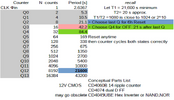You said you wanted minimum parts and accurate timing. If you are
new to programming then block language programming quite simple
and straight forward.
The ATTINY85 8 pin micro can do this in one part (plus bypass cap for it and
a regulator), code it with mBlock. mBlock takes your block configuration, shown
in right hand window, and converts that to Arduino code. Note in addition to the
part you of course need interface switch for motor power......
I think this example would be a good basis for design. Question, what causes loop
to stop, powering off whole system ?
View attachment 144593
You program the ATTINY85 with a Nano board configured as a programmer, thats
just a firmware you burn into Nano board. Nano board ~ $3. Note if you use Nano
Board as target its timing error < .1% as its has a xtal on board. If you use ATTINY85
as target its timing tolerance is ~ +/- 1% over T and V.
So if design is a one off, use the board, simple. Otherwise config board as programmer,
easy with Arduino IDE, videos on this, and use the ATTINY85.
Just a thought.....
Regards, Dana.




